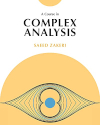- About MAA
- Membership
- MAA Publications
- Periodicals
- Blogs
- MAA Book Series
- MAA Press (an imprint of the AMS)
- MAA Notes
- MAA Reviews
- Mathematical Communication
- Information for Libraries
- Author Resources
- Advertise with MAA
- Meetings
- Competitions
- Programs
- Communities
- MAA Sections
- SIGMAA
- MAA Connect
- Students
- MAA Awards
- Awards Booklets
- Writing Awards
- Teaching Awards
- Service Awards
- Research Awards
- Lecture Awards
- Putnam Competition Individual and Team Winners
- D. E. Shaw Group AMC 8 Awards & Certificates
- Maryam Mirzakhani AMC 10 A Awards & Certificates
- Two Sigma AMC 10 B Awards & Certificates
- Jane Street AMC 12 A Awards & Certificates
- Akamai AMC 12 B Awards & Certificates
- High School Teachers
- News
You are here
A Course in Complex Analysis

Publisher:
Princeton University Press
Publication Date:
2021
Number of Pages:
448
Format:
Hardcover
Price:
65.00
ISBN:
9780691207582
Category:
Textbook
[Reviewed by , on ]
Mark Hunacek
04/10/2022
This is a graduate-level introduction to complex function theory. The author’s elegant writing style, and interesting selection of topics, sets this book apart from the competition and makes it a good choice for a reference, or a textbook for a fairly sophisticated (one or two semester) graduate course.
It is apparent from the very beginning that this is not a book for beginners. Most complex analysis books, even graduate-level ones, begin with the very basics (complex numbers, norms, functions, limits, and continuity), but this book spends one page on this introductory material and then immediately proceeds, in section 1 of chapter 1, to a discussion of complex differentiation and holomorphic functions. Chapter 1 provides a succinct and efficient discussion of about half of a typical undergraduate course on complex analysis: differentiation and integration, Cauchy’s integral theorem and integral formula for a disk, Liouville’s theorem and the fundamental theorem of algebra, power series, open mappings, and the maximum principle.
The next chapter is topological, discussing both the homotopic and homological version of Cauchy’s theorem. Chapter 3 then returns to topics that are mentioned in undergraduate courses: poles, residue theory, Laurent series, Rouche’s theorem, and the argument principle. Another topic that is often mentioned in undergraduate courses is Mobius transformations, and they are the subject of chapter 4, but in a much more sophisticated way than is customary at that level, including such topics as the dynamics of Mobius transformations and conformal metrics.
These four chapters account for a bit less than one-third of the text. The remainder of the book is devoted to topics that are definitely graduate-level, covered in a modern way that emphasizes the geometrical and topological aspects of the material. Topics covered include, for example, the Riemann mapping theorem, the theorems of Picard and Montel (several approaches), infinite products, normal families of meromorphic functions, holomorphic (branched) covering maps and the uniformization theorem for spherical domains.
The author’s writing style is very appealing—concise, but clear, and with lots of marginal notes inserting historical tidbits into the discussion. As noted above, however, this is not a book for beginners. A good background in undergraduate point-set topology and analysis is assumed, for example, and some prior exposure to complex analysis, though not strictly necessary, would likely be valuable. The exercises in this book (of which there are many) also require some strong background; most seem non-routine, and there are no solutions in the book.
The back-cover advertising says that this book is accessible to, among others, “advanced undergraduates with some background” in analysis and topology. This is, I think, wishful thinking. But for well-prepared graduate students, or mathematicians wanting a good reference book on the subject, this is a solid choice.
Mark Hunacek (mhunacek@iastate.edu) is a Teaching Professor Emeritus at Iowa State University.
See the publisher's website.
- Log in to post comments




